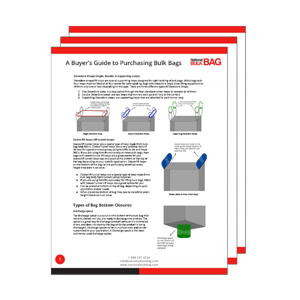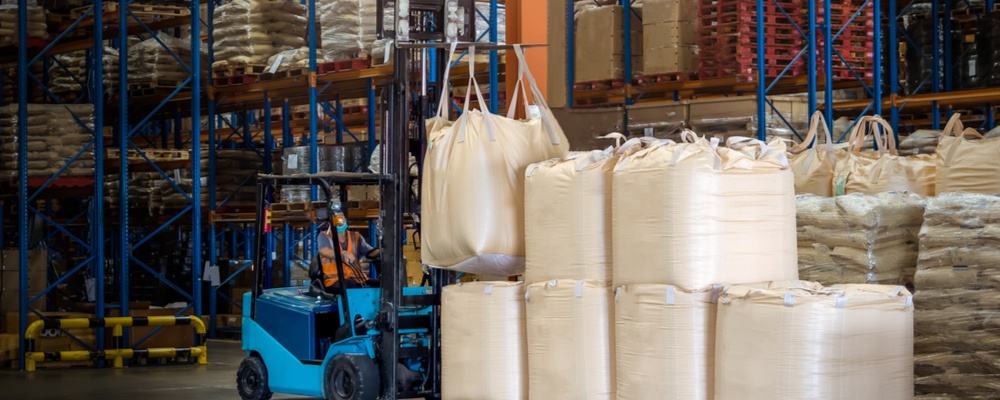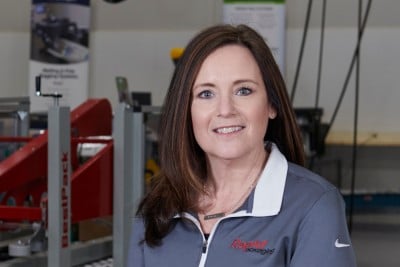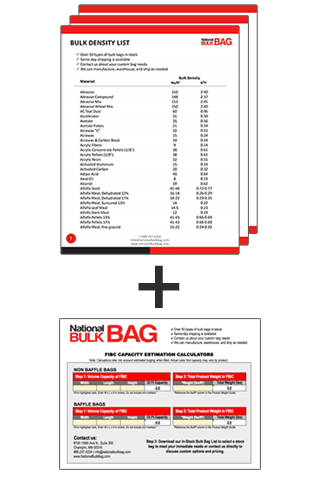We are committed to educating and sharing our industry knowledge with our website visitors and customers. That is why we continue to put together educational blog posts like this one that are informative and hopefully add value to your organization.
In this post we give you 5 keys to choosing the right bag that most other bulk bag suppliers won't tell you. For regular updates, subscribe to our blog by filling out the "Subscribe to Our Blog Updates" form to the right.
1) Know your product
To ensure that the product you're packing will not exceed the SWL (safe working load) of the bag you are interested in, you'll need to know the bulk density of the product you're packing. To easily determine the bulk density of your product, download our Product Weight Guide by clicking here. You will also want to know a few other basic things such as:
- Is your product food grade?
- Is your product hazardous, flammable, or explosive?
- Is your product fine? Will it possibly leak through the seams of the bag?
Having these questions answered before you speak with a supplier will save you time and quite possibly save you money.
2) Know how you are filling and discharging your bag
Knowing how you fill and discharge your bag is imperative. How you fill and discharge your bag will help determine the bag’s optimal top and bottom. You will also want to have a few other basic questions answered such as:
- Are you using machinery to fill your bag? Does your filling machine require a specific sized spout?
- Will the bag be suspended when filled or discharged?
- Do you need the ability to regulate the flow of the product?
Knowing these answers before you purchase bags will prevent you from making purchasing mistakes. For more information on filling and discharging options, check out these blog posts:
3) Don't pay extra for unnecessary options
There are a lot of customization options for FIBCs but they usually come with and additional cost and are not always necessary. You can save your business a lot of money by making sure that the bag that you buy is only equipped with the options that are necessary for your application. Some examples of customization options that cost additional money, but might not be necessary for your application, include:
- Coating
- Sift resistant seams
- Baffles or net baffles
- Vent strips
- Color
- Fabric weight used
When going through the buying process, make sure to let the solutions expert that you are working with know that you do not want any customizations that aren't necessary for your application. Don't hesitate to ask questions! The jumbo bag solutions provider should be ready and willing to answer and discuss all your questions.
4) Don't pass up necessary options, even if more expensive
This seems self-explanatory, but it happens more than you might think. Although additional options/customizations may cost you more money up front, they may save you money in the long run. A good demonstration of this is using sift-resistant seams when necessary. If your specialist is suggesting the use of a sift-resistant seams, it’s most likely because the product you're packing will leak through the seams of the bag. If you choose not to use sift-resistant seams when necessary, the cost of product loss can exceed the cost of the additional option(s).
5) Know how you are handling/moving your bulk bag.
Knowing how you are or will be handling/moving and transporting your bags will help you and your FIBC specialist determine what specific type of lift loops your bag should be equipped with. Are you handling/moving your bag using a forklift? You will most likely want to purchase bags with cross corner loops or even better, sleeve loops/lift tunnel loops. Using a crane to handle/move your bag? You will most likely want a bag equipped with one or double stevedore loops.
For more information on different types of lift loops, check out our blog post "FIBC 101: Types of Lift Loops Explained" by clicking here.
Thanks for reading!
 Thanks for reading our blog post "What Other Distributors Won’t Tell You – 5 Keys to Choosing the Right Bulk Bag"!
Thanks for reading our blog post "What Other Distributors Won’t Tell You – 5 Keys to Choosing the Right Bulk Bag"!
It's our mission to make your bag buying experience easy, informative, and enjoyable. We also want to share our knowledge with you so you can make the best purchasing decision for the company you represent. Our Buyer's Guide to Purchasing Bulk Bags includes critical information ranging from types of FIBCs to important safety information about handling and transportation.
Click the button below to download our comprehensive buyer's guide.







